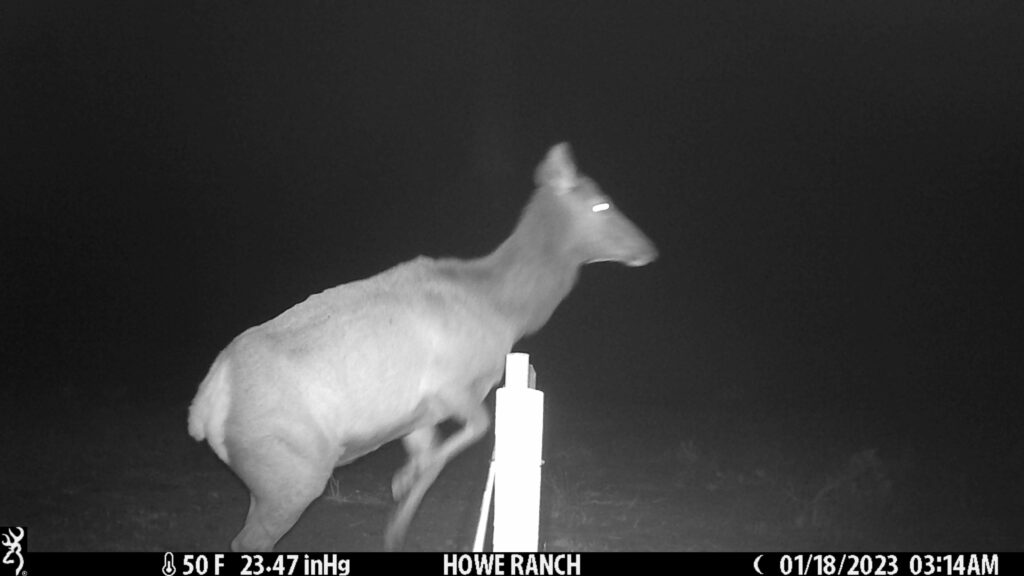Where the Elk, Deer, and Antelope Play
The Emery-Wilhelm Family Agricultural Resiliency Fund
Takes off with Pilot Projects
By: Karina Puikkonen
January 23, 2024
The Colorado Cattlemen’s Agricultural Land Trust’s Additive Conservation Program established the Emery-Wilhelm Family Agricultural Resiliency Fund, referred to as the ARF, in 2023 to provide landowners with financial support for projects that contribute to the long-term ecological health and economic viability of conserved working lands.
A team from the Yale School of the Environment’s Ucross High Plains Stewardship Initiative helped CCALT develop a model for the ARF fund and identified current project needs that include improving water infrastructure, fire mitigation and forest health, and grassland health and grazing efficiency. The first pilot projects for the fund were completed in Fall 2023, allowing a few of CCALT’s landowner partners to address current agricultural and conservation needs on their conserved lands.
A Sense of Place
A sense of place originally brought Emily Howe’s parents to Northwest Colorado, and that is what has kept her family on the land for nearly 50 years.
“My parents wanted to live in the middle of nowhere,” Howe said. “The way they found to do it was by ranching.”
In the 1970s, Howe’s parents bought property in Routt County that became Howe Ranch and started a cattle and hay operation on a shoestring budget. But Howe said the main thing they wanted to do was to live in the solitude and space that rural communities provide.
The land had been traditionally used for agriculture since the late 1800s, with excellent habitat for summertime livestock grazing and wildlife alike. The lush hayfields fed the Howes’ cows and horses; the sagebrush and shrublands supported large numbers of ungulates, sage grouse, and migratory songbirds; and the creek and wetlands supported them all.

While growing up, Howe’s parents managed the ranch. Howe became a botanist who currently works for Colorado State University, while her husband is a wildlife biologist for the Routt National Forest. She and her husband took over management of the ranch in 2022 but have made their primary living through their careers.
Because of the example and precedent set by others in the area, the Howe family partnered with CCALT in 2009 to put a conservation easement on the ranch. This ensured the open space and natural habitat would always be there, and their future ranch maintenance needs could be supported through a fund they created from the easement proceeds.
“We don’t feel like we need an extractive revenue generator,” Howe said. “CCALT is a big part of the reason for what we want to do in our generation; our parents and CCALT set it up so we could remain on the land and manage it the way we want.”
Over the Fence
The Howes sold their cattle in 2011 and have primarily managed the ranch for native wildlife and habitat since then. Much of the old woven wire fencing that was there when they bought the ranch in the 70s had been previously used for sheep. The heavy snows each winter compressed the fence down and summer vegetation grew above it, making the fence a perfect snag for unsuspecting wildlife, especially during fall migrations.
“We’ve seen pronghorn fawns, elk fawns, and full-grown deer get stuck in fences,” Howe said.
While they maintain their fences consistently, one of the Howes’ primary conservation projects is to remove much of the interior fencing on the ranch that was used for livestock and convert the perimeter fencing to be wildlife friendly. This will make wildlife migration easier for all the ungulate species, as well as sage grouse that require large contiguous sagebrush and grassland areas for nesting. One specific mile-long stretch has been the most important to tackle first as it is along an important elk migratory route.
“For a few months each year elk travel back and forth each night, and for 600-700 animals to cross that fence it takes a toll on the fence, and a toll on the elk to constantly jump it,” Howe said.



An elk crossing the old fence in January 2023. Photo credit: Jeremiah Psiropoulos
The Howes self-funded a portion of the one-mile fencing project, but the scale of the project required extra financial support. They secured labor and material funds from their local Colorado Parks and Wildlife Habitat Partnership Program, and the ARF funds from CCALT helped them purchase the wooden posts for the fence line. This additional funding helped them completely replace the one-mile of old fencing with a new four-wire design built according to CPW’s standards for wildlife friendly fences. Howe said their conservation approach is to maintain their pocket of land for native habitat and to help wildlife populations.


“Most of our area is used for seasonal cattle grazing, and we feel it’s important to have areas that aren’t grazed to maintain land in its natural state,” Howe said. “We enjoy seeing the native wildlife and we can provide a benefit to the larger biodiversity in our region.”
Under the Howes’ past and present management of the ranch, they have also seen improvements in the riparian habitat along Calf Creek, including regeneration of cottonwoods, young saplings, and vegetation. As scientists and land managers on public lands in their region, Emily and her husband want to continue conservation projects on the Howe Ranch that include inventorying plants and small mammals and start new restoration efforts that will benefit the land.

